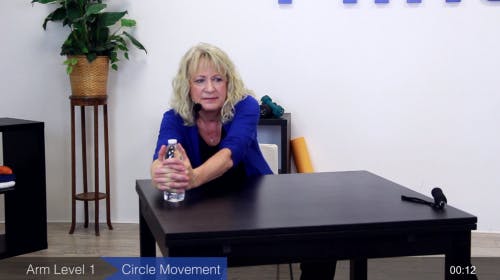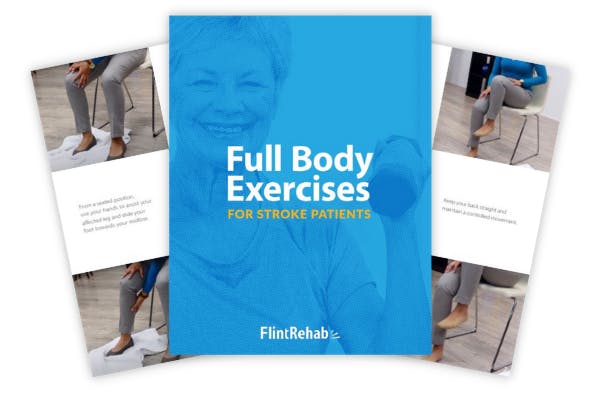Arm Exercises for Stroke Patients: Helpful Movements for All Ability Levels

This arm exercise involves a gentle stretch. Start by lacing your fingers together. Then gently stretch by rotating your affected arm palm-side up. Hold for 20 seconds, and stretch to a strong, but tolerable point. You may feel some discomfort, especially if your muscles are really tight, but it should not be painful. Never stretch to the point of pain.
2. Wrist Stretch

Let’s move down to the wrist to keep stretching the upper extremities. While keeping your fingers laced together, gently bend your affected wrist backward. Hold for 20 seconds and release. You can do this stretch with your elbow bent or your elbow straight to change the intensity. Again, the stretch should be strong, but tolerable.
3. Cane Reach

Now let’s get the shoulder involved. This exercise will help improve the mobility you need to reach over your head (think: reaching for that high shelf or putting on a shirt). For this final upper extremity stretch, hold both ends of a cane. Then use your other side to gently lift your affected arm up to the side. You can rest the cane on your leg for stability if it’s difficult to hold.
Hold this arm stretch for a few seconds before gently releasing. Be mindful of only stretching to a point of stimulation but not pain. If you would like an additional stretch, turn your head and rotate your trunk to that side. You can also try using your other arm to lift the affected side straight forward and up.
Level 2: Easy Arm Exercises for Stroke Patients
These arm exercises for stroke patients are great for anyone with limited mobility in the upper extremities. Exercises should always be challenging, but not frustrating. Start where you feel comfortable for continued success.
These arm exercises should be accessible to most people, including those with post-stroke paralysis. The exercises involve stretching and active-assisted movement, which helps you retrain your brain to use your affected arm again, but with a little help of the other side. The more you move it, the more you improve it!
4. Straight Push


For this arm exercise, start seated at a table with a water bottle in front of you. Interlace your fingers and rest your forearms on the table. You can put your hands on a small hand towel to reduce friction and make the sliding a bit easier.
Then, push the bottle across the table by gliding your arms across the table. If you lean your chest forward while you reach, it’ll get a little extra stretch! Try your best to avoid elevating your shoulder (a common synergistic pattern).
If a muscle group is unable to perform the movement, a stronger or larger muscle group will substitute to complete the task. Our bodies like to take the easier path of least resistance, but you should try to focus on moving your arm without those compensations.
Slowly guide your arms back, bending your elbows until you are sitting upright again. Repeat this arm exercise 10 times.
5. Circle Movement


For this upper extremity exercise, lace your fingers together and wrap both hands around the water bottle. Then, make large circular movements with your arms. As you move around in this big circle, focus on stretching your affected arm. You may feel a stretch through your shoulder, sometimes all the way down to your wrist.
Perform 10 large, slow circles for this arm and hand exercise. When you move in one direction, always reverse the direction. One way builds strength, the opposite way reduces tension.
6. Cane Leaning


Start by sitting in chair with your legs hip-width apart (for safety) for this arm exercise. A wider base of support gives you more stability.
Then, place your affected hand on a cane, and place your other hand on top for stability. Gently lean to the side and feel the stretch. This provides weight bearing into the affected side of your body.
Hold for 20 seconds and return to an upright position. Safely repeat 5 times.
Level 3: Moderate Stroke Exercises for the Arms
Now we’re getting to more difficult arm exercises for stroke patients. While many people can do these exercises, those with severe spasticity or paralysis may not yet. That’s okay, because effective arm exercises for stroke patients are not about doing the hardest movements first. It’s about stimulating the brain with therapeutic movements that suit your ability level.
Try not to get frustrated. Instead, stay where you feel challenged but still able to perform the movements. Focus on high repetition to activate neuroplasticity, and progress to the next level when you’re ready.
Here are some moderately challenging arm exercises for stroke survivors:
7. Punching Movement


Place your forearm on a table with your hand in a fist. Then, slide your arm forward to ‘punch’ a water bottle. Then, pull your arm back towards you while still keeping your forearm on the table, bending the elbow and drawing the shoulder blade back
Again, try your best to avoid shrugging your shoulder. It is better to perform the movement slowly and mindfully than substitute the wrong muscles. Repeat this punching movement 10 times.
8. Pushing Movement


For this arm exercise, place a water bottle on one side of the table within your range of motion. Then, hook your wrist on the outside of the bottle.
Use your arm to push the bottle across the table. If you can do this without moving your body, great! If you need to move your body to accomplish this task, that’s also beneficial. You’re still retraining your brain and working on regaining arm movement.
When you’re done, hook your wrist on the other side of the bottle and push it back across the table. Repeat this back and forth pushing a total of 5 times.
9. Unweighted Bicep Curls


You may notice that rehabilitation exercises are different from the exercises you see trainers doing in the gym. That’s because we’re focused primarily on retraining your brain, and engaging your muscles in movement.
For this exercise, start with your elbow on a table with your arm bent at 90 degrees. Then, bend your elbow to curl your arm up as far as you can, then release it back down to the table.
The upward motion activates your biceps to lift your arm, while the downward motion focuses on controlling the weight of your arm back down. Both are equally important for coordination of movement.
Also, notice how small the movement is at first. Start with small movements and try to increase your range of motion and make slightly larger movements each time. The best exercises for the arm and hands after stroke are not the ones done with speed, but with intention.
Level 4: Difficult Stroke Recovery Exercises for the Arms
These upper extremity exercises are the most difficult in this list. If you can’t do them yet, don’t be discouraged. You can work your way up to them as you progress through your at-home arm therapy regimen.
10. Weighted Bicep Curl


For this strengthening arm exercise, hold a water bottle in your affected hand and leave your arm down by your side. Then, while keeping your elbow glued to your side, bring the bottle up to your shoulder. Then bring it back down just as slowly.
You need to work on slowly lifting the weight up and slowly back down in order to develop more balanced arm control. Complete 10 bicep curls.
11. Open Arm Movement


From a seated position, hold a water bottle with your affected hand. With your arms bent at 90 degrees, open your arms up so that your forearms come out to your sides.
Keep your elbows pinned to your sides as best you can. Focus on squeezing your shoulder blades together and keeping your chest up. Then, move your arms back to center and repeat this arm rehab exercise 10 times.
12. Side Arm Raise


This is the most difficult upper extremity exercise that targets the hand, arm, and shoulder. Be extra mindful about doing the movement correctly.
While sitting on the edge of your chair, bed or couch, hold a water bottle in your affected hand and place your arm out to your side.
Lift the water bottle up while keeping your arm straight. It is essential that the movement is throughout your arm rather than simply shrugging your shoulder or leaning to the side.
With slow and controlled movement, lower your arm back down. Complete this movement a total of 5 times, trying to hold it at the top for 2-3 seconds.
Level 5: Resistance Training Arm Exercises for Stroke Patients
If you have sufficient mobility in your arms, then resistance training is a great way to reverse any muscle atrophy that may have occurred during recovery and improve muscle strength. Resistance training utilizes load, such as weights, machines, resistance bands, or even your own body weight.
We included these last because they should only be attempted with clearance from your therapist and sufficient mobility to achieve the movements safely. An effective arm therapy regimen does not depend upon strength training. It depends upon what keeps you feeling both challenged and motivated.
For these more advanced arm exercises, you can use dumbbells, resistance bands, water bottles, or even canned food for that little extra weight. For all of these strength-building rehab exercises, perform them in a slow and controlled fashion.
13. Sitting Elbow Flexion
This exercise targets your bicep muscles, which are important for lifting and carrying things. Grab your weights and start with your arms at your side (if you’re using a band, hold both ends while anchoring it underneath your feet).
Then, while keeping your elbows close to your sides, bend your arms to bring the dumbbells towards your shoulders. Try to keep your palms facing up the entire time.
Return to the starting position, making sure that your elbows stay close to your side. Do 2-3 sets of 10 repetitions.
14. Overhead Press

With your weights in hand, position your arms out so that your elbows are bent at 90 degrees. Your upper arms should be parallel to the floor and palms facing forward.
Push the weights up over your head, straightening your arms over your shoulders. Try to keep your posture and move both arms symmetrically. Do 2-3 sets of 10 repetitions.
15. Shoulder Abduction
Sit comfortably with your arms relaxed at your sides, weights or resistance band in hand. With your arms straight, lift your arms out to a “T.” Then, slowly lower your arms back down. Do 2-3 sets of 10 repetitions.
If you want a beautiful PDF that contains stroke recovery exercises just like this, but for the full-body, be sure to grab our free ebook below! We created it for survivors that are looking for effective arm therapy to do at home.
Keep it Going: Get a Free Rehab Exercise Ebook (25 page PDF)

Get our free ebook filled with 25 pages of rehab exercises featuring photos of licensed therapists. Sign up below to get your copy!
When you sign up, you’ll also receive our popular Monday newsletter that contains 5 articles on stroke recovery.
We never sell your email address, and we never spam. That we promise.
